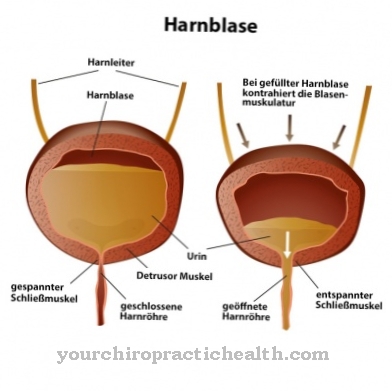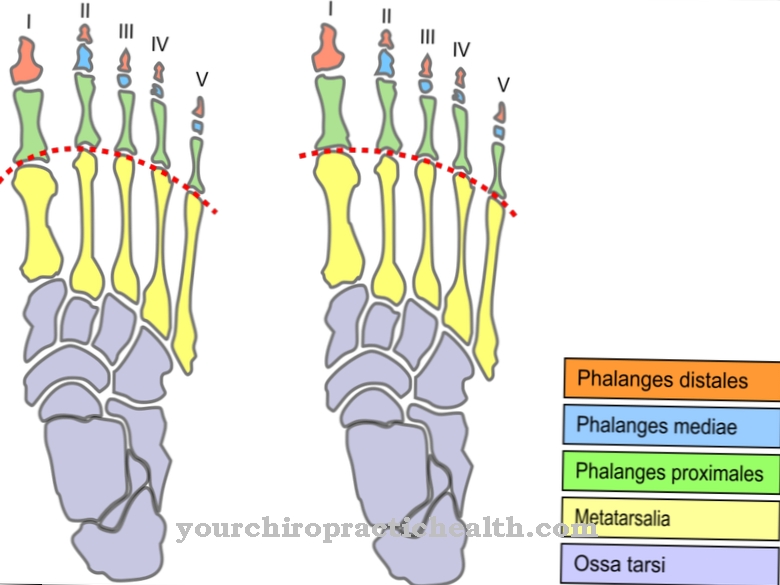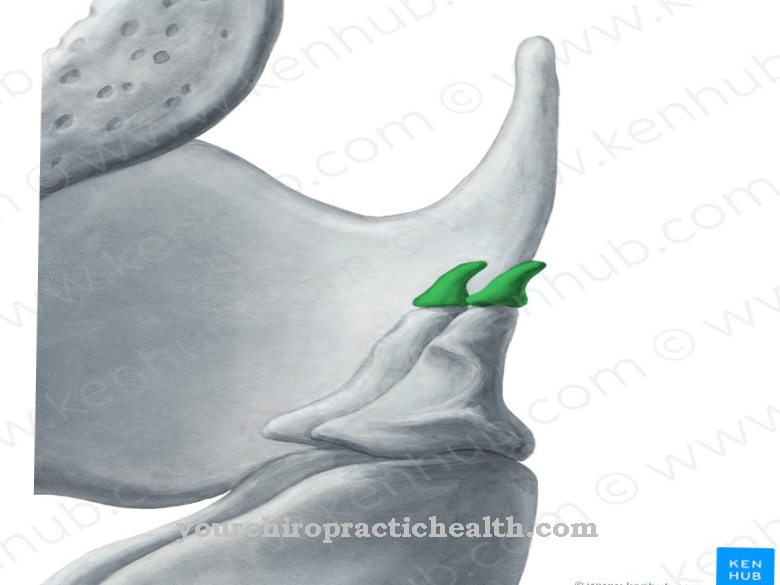As rod the photoreceptors of the retina responsible for light-sensitive monochromatic night vision and for peripheral vision are called. The main concentration of the rods is outside the central yellow spot (fovea centralis) on the retina, which is mainly equipped with three different types of cones for color and sharp vision during the day and at light twilight.
What are chopsticks?
The approximately 110 million rods on the retina are photoreceptors that react to light impulses much more sensitively than the approximately 6 million cones. The rods are therefore predestined for night vision (scotopic vision) and vision at dark twilight. Because there is only one type of rod that is particularly sensitive to light in the blue-green spectral range, vision becomes monochromatic below a certain brightness.
Different colors are no longer perceived. The high light sensitivity is partly at the expense of the contrast. Because up to 20 rods report light impulses via bipolar cells to the same ganglion, the visual center in the brain can no longer locate the light impulse as precisely as with the cones, which are often connected to “their” ganglia in a 1: 1 ratio. Although the principle of converting light pulses into electrical nerve signals is basically the same for rods and cones, the messages from rods are significantly faster than those from cones because there are fewer interconnections. This means that rods react extremely sensitively not only to light, but also to moving objects in the peripheral field of vision.
Anatomy & structure
The structure of the rods is similar to that of the cones, but the rods are slimmer and use rhodopsin as a visual pigment, the highest sensitivity of which is in the blue-green range at 498 nanometers. The rods consist of the cell body, synapse, inner segment, connecting cilium and outer segment.
The inner segment takes care of the cell metabolism and, by means of thousands of mitochondria in the nucleus, the energy metabolism, while in the outer segment the conversion of the light impulses into electrical nerve signals, the visual signal transduction, takes place. The outer segment contains more than 1,000 so-called disks, in which the visual pigment rhodopsin is stored.
The disks are the result of former membrane invaginations that have detached from the outer membrane in the course of evolution. In contrast to this, the membrane indentations in the outer segments of the pegs are still recognizable as such because they have remained part of the membrane. The marginal connecting cilium, which consists of nonagonal microtubules (9-sided polygon), serves to mechanically stabilize the connection between the inner and outer segments and to transport substances between the two segments.
Function & tasks
The main function of the rods is to convert (weak) light impulses into electrical nerve impulses. The process involves a complex signal transduction cascade and takes place mainly in the outer segment. The first stage consists in the reaction of the visual pigment rhodopsin, which consists of opsin and the carotenoid 11-cis-retinal. After exposure to light, the 11-cis-retinal isomerizes to the all-trans isomer and separates again from the rhodopsin.
In contrast to the activation of other neurons, which are usually stimulated to release a neurotransmitter by a short-term depolarization from -65 mV to +10 to +30 mV, the photoreceptors work the other way around, those with around -40 mV negative Charged synapses are briefly hyperpolarized to -65 mV, so that they temporarily reduce or stop the release of glutamate, your specific neurotransmitter.
The corresponding nerve impulse is not generated by the release of a messenger substance, but by reducing the release. If no light hits the receptors (rest position), glutamate is constantly released at the synapses of the photoreceptors. This has the advantage that the downstream ganglia can gradually vary the nerve stimulus depending on the intensity of the incident light, i.e. generate a kind of analog signal that not only allows the visual centers to assign the points of light spatially, but also their brightness.
The ability of the rods to react extremely sensitively to objects in the peripheral field of vision that move in relation to their surroundings originally served our protection. Enemies or predators approaching from the side were noticed early. Today, this ability of the chopsticks plays a role in visual flying, as objects approaching from the side are noticed at an early stage and evasive maneuvers can be initiated.
You can find your medication here
➔ Medicines for visual disturbances and eye complaintsDiseases
Functional disorders of the rods are particularly noticeable in impaired night vision. A widespread reversible night blindness occurs with an insufficient supply of vitamin A, because then not enough visual pigment rhodopsin can accumulate on the discs in the outer segment of the rods.
Symptoms of a dysfunction of the rods can also be attributed to increased sensitivity to glare, e.g. B. recognize oncoming traffic. Apart from the undersupply of vitamin A and nerve lesions as a result of a traumatic brain injury (TBI), a brain tumor or other injuries, the functional disorders of the rods are mostly due to genetic defects. These are mostly genetic defects that lead to retinal dystrophies of various types and gradually destroy the photoreceptors in the retina.
Retinitis pigmentosa is a retinal dystrophy that progresses from the outside in. This means that the rods are the first to be affected and the typical night blindness and sensitivity to glare set in, although daytime vision does not (yet) have any restrictions in terms of sharpness and color vision. Other retinal dystrophies such as cone-rod dystrophy (ZSD) progress from the inside outwards, so that the cones are affected first and only later the rods.








.jpg)



.jpg)



.jpg)







.jpg)


